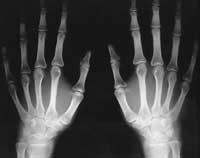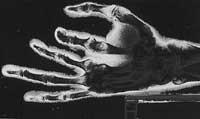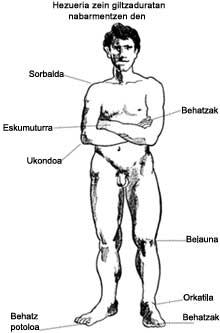| Rains, weather changes, winter storms... any reason is enough to talk about the kingdom. However, saying “I am affected by rheumatism” has neither foot nor head; rheumatism, in fact, is nothing and at the same time can be much. That is what they first try to clarify in the Rheumatology Sections. When talking to friends, because rheumatism is considered a single disease, but if you ask a rheumatologist, he will tell you that generic name contains more than 200 diseases. What is rheumatism? In the Department of Rheumatology of the Hospital Nuestra Señora de Arantzazu in Donostia we met our two interlocutors, doctors Isaac Plazaola and Olga Maiz. From his consultation, from his hands, many machines pass daily sick and sick. “When people tell you that it is devastated, in general, they want to tell you that they have noticed some problem, symptom, in the locomotor apparatus, but the problems that people consider as a single hangover can be very varied” We have talked with these two young doctors in the thread of the data that just published the Spanish Society of Rheumatology. According to these data, among those over 16 years of age, about 33% of the population recognizes having a rheumatic disease, 80% know well what it is to be lumbed, 1% suffer from rheumatoid arthritis and, finally, among women over 60 years of age, 20% have suffered some fracture due to osteoporosis. It is the most visible group of diseases in general medicine and the first agent of disability. 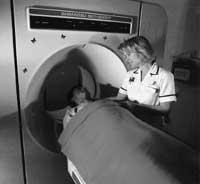 According to the latest data, rheumatic diseases are becoming more and more frequent. The most common is lumbago (according to the Spanish Society of Rheumatology, 80% of the population knows well what it is to be affected by a lumbago. According to our partners, “these data indicate that rheumatic diseases are very important. Even if they are normal, they should not be taken in jokes. In fact, the genus of rheumatism denominations encompasses about 200 diseases. These pathologies can also be infectious –caused by some germ–, autoimmune –our internal defenses, for unknown causes, as a consequence of our fight against us-, degenerative and even psychological in some cases.” In general, rheumatism is the generic designation of a broad set of diseases that affect the locomotor apparatus (bones and joints) and muscles, tendons and other nearby elements, and that, as Plazaola and Maizek have clarified, currently houses around 200 diseases. They produce acute pain, inflammation and functional problems; they can be manifestations of another disease or signs of malfunction of another device. Are they incurable? “It is a question they ask us many times,” our interlocutors told us. People have heard the motto that says: ‘The child won’t kill you, but it’s lifelong.’ As mentioned above, rheumatism is not a disease, but a large number of diseases, so the development and diagnosis of all pathologies cannot be put in the same bag. When it comes to answering this question, therefore, we cannot help what has happened to us worried: sometimes they heal and sometimes not”. However, Plazaola and Maiza wanted to clarify that all diseases, medicinal or incurable, must be treated by all: “Until now we know that diabetes is an incurable disease; however, the patient does not pass through the head the refusal to treatment, the non-injection of insulin, which is what he must do all his life.” Where to go? 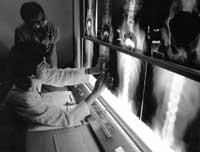 X-rays are very useful for the diagnosis of some diseases. However, there are rheumatic diseases that are not “seen” on x-rays. Lack of definition and abundance of diseases cause more than one headache. Isaac and Olga tell us that “people don’t know where they have to go and sometimes doctors don’t help them. On the one hand, there are professionals of general medicine; the patient, first of all, must go to the local doctor and analyze these symptoms. Sometimes the problem ends there, because the treatment of some diseases is very simple and fast. At other times, the patient will need a more accurate diagnosis and treatment and the doctor will send the rheumatologist. It will be made available to the rheumatologist and will be the one who tracks your disease. In cases where the rheumatologist deems it appropriate, he will recommend orthopedic or surgical treatment, in which case these consultations will be referred to the traumatologist.” Arthrosis Osteoarthritis is a degenerative disease that affects one or more joints. It attacks the cartilage that facilitates the movement of the joints: it loses flexibility and consistency, which prevents it from performing its functions. Although it is thought otherwise, osteoarthritis is not associated with old age, not all older people have osteoarthritis and, on the contrary, it also occurs among young people. According to some doctors, this pathology is directly related to our sedentary life, since fewer cases have been observed in human groups that do not have a comfortable life. Today, osteoarthritis is a chronic and incurable disease. There are no remedies that deal with its origin, since the main factor that activates the degenerative process is not known. However, osteoarthritis is completely formed by initial treatment. Rheumatologists currently study two types of osteoarthritis. Primary osteoarthritis is the best known among women aged 40 to 50, that is, occurs in the premenopausal phase; it appears in crops, knees and lumbar area in most cases. Secondary arthrosis is more common than the previous one; metabolic or blood composition defects have been mentioned as triggers of secondary arthrosis and it has been observed that, in addition to the previous ones, they can be caused by local joint lesions. In general, acute pain and motor dysfunctions are the main symptoms of this disease, since the patient's discomfort depends on the affected element. Rheumatologists usually say that it produces a “three-phase pain”: at rest the pain is minor and reappears with the onset of activity; then, the joint movement put can shorten the symptoms, but reappears in the short term. In times when atmospheric pressure, humidity and temperature change often, patients often say that the pain is greater. In turn, the more obese patients tend more to the pressure exerted by the body's own weight on the joint cartilage. As mentioned above, it mainly affects women and is generally said to have nothing to do with inheritance, although in the case of primary osteoarthritis it is considered that this factor can directly influence. | Rheumatism in soft aspects They are diseases that occur in the locomotor apparatus and that affect structures close to the joints, mainly tendons and serous bags that facilitate their movements. They can occur from trauma, shock, or other rheumatic diseases. Its absence in X-rays is completely normal, so for the diagnosis of tendinitis, for example, the information provided by the patient is usually the most reliable source of the rheumatologist. | Osteoporosis For many it will be a disease of new century. Associated with old age, it is increasingly frequent due mainly to the increase in life expectancy. By definition, osteoporosis is the general demineralization of the skeleton, since metabolic alterations cause the bones to lose density and substance and, consequently, consistency. As we said, this disease is increasingly common in our society. It is also related to changes that occur in menopause and according to the latest data, 20% of women over 60 are affected. Some experts believe that osteoporosis can also be considered an inherited disease. Although there is no total relationship, it is observed that the children of women affected by osteoporosis have a greater propensity to the disease, since our bone mineral content, like the color of the eyes, is part of our genetic code. Although the genetic factor is important, it is possible to fight the disease. It does not necessarily appear, although there is a tendency in the family. Proper diet, solar energy that helps synthesize vitamin D or even physical exercise are the most effective preventive measures that can be taken before the disease. | Arthritis It is a rheumatic disease that causes redness, pain, warmth, and even swelling of the joint. As a defense, tissues respond by inflammation, increasing blood circulation. The ultimate goal of inflammation is therefore to increase joint involvement. As for the symptoms of arthritis, the first thing that is noticed is the redness, which produces a redness of the skin around the affected joint, with the consequent supply of heat and inflammation. The pain does not go away at rest, making joint movements difficult. The origin of this disability may be pain or inflammation itself. These are general symptoms of origin, onset of arthritis. Taking as a criterion the factor that gives rise to the inflammatory process, several types of arthritis can be distinguished: - Inflammatory arthritis: is a generic name, as it contains many different pathologies. In general, it affects several joints while fever or other defense mechanisms accompany inflammation. In this group are, for example, rheumatoid arthritis, ankylosing spondyloarthritis, psoriatic arthritis, etc. According to the latest data provided by the Spanish Society of Rheumatology, about 1% of the population suffers from rheumatoid arthritis. It is an autoimmune disease: internal defenses collide with our body and, in general, symmetrically affects the joints of hands and feet. The stages of its development are well known today, but to this day there is no reliable data on the origin of rheumatoid arthritis; researchers consider that it is multifactorial, that is, it may be influenced by genetic, immunological or environmental factors.
- infectious arthritis: diseases caused by bacteria, viruses or parasites. The infectious agent acts from the inside of the joint, leading to a cover or abscess.
- metabolic or microcrystalline arthritis: disease caused by metabolic disorders. The best known of this group is the drop or drop. The accumulation of uric acid crystals in the joints produces the symptoms of arthritis. These crystals to diagnose gout should be observed in the joint fluid, so it is not enough that the level of uric acid is above normal to necessarily predict gout.
| |
